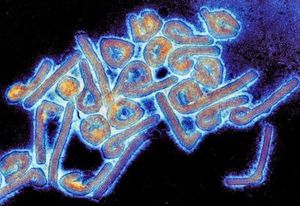Natural Killer Cell: Difference between revisions
(Created page with "==Introduction== Select a topic about genetics or evolution in a specific organism or ecosystem.<br> The topic must include one section about microbes (bacteria, viruses, fung...") |
No edit summary |
||
| Line 1: | Line 1: | ||
==Introduction== | ==Introduction== | ||
Natural killer cells (NCKs) are a set of granular cytotoxic lymphocytes that are non-adherent and non-phagocytic [1]. They provide important rapid response to viral, and, sometimes, microbial, infections and tumor onsets. [1,2] NCKs share many features with leukocytes of the innate immune system, such as granular cytoplasm, spontaneous activity, and susceptibility to positive regulation by immune stimuli. [1] However, research has shown that NKCs activities are specific to a certain level against different types of pathogens to promote a certain level of efficiency and allow self-tolerance, and can be regulated by complex intercellular signals, characteristics common to the adaptive immune system. [1,5] Thus, NKCs are now considered to be a conjunction point of both the innate and adaptive immune systems. In the innate immune system, NCKs are detectors for infected, especially virally infected, cells and tumorous cells, which can evade phagocytosis by macrophages and other lymphocytes of the first-line immune response. This immune surveillance function [1] follows the “missing self hypothesis” [5] that is associated with major histone-compatibility (MHC) protein class I receptors. NKCs can also be stimulated by dendritic cells via cytokine secretion. [5] | |||
[[Image:marburgvirus.jpg|thumb|300px|right|Colony of Marburg virus. Transmission electron microscope image taken by Dr. Tom Geisbert]] | [[Image:marburgvirus.jpg|thumb|300px|right|Colony of Marburg virus. Transmission electron microscope image taken by Dr. Tom Geisbert]] | ||
Revision as of 04:01, 8 November 2019
Introduction
Natural killer cells (NCKs) are a set of granular cytotoxic lymphocytes that are non-adherent and non-phagocytic [1]. They provide important rapid response to viral, and, sometimes, microbial, infections and tumor onsets. [1,2] NCKs share many features with leukocytes of the innate immune system, such as granular cytoplasm, spontaneous activity, and susceptibility to positive regulation by immune stimuli. [1] However, research has shown that NKCs activities are specific to a certain level against different types of pathogens to promote a certain level of efficiency and allow self-tolerance, and can be regulated by complex intercellular signals, characteristics common to the adaptive immune system. [1,5] Thus, NKCs are now considered to be a conjunction point of both the innate and adaptive immune systems. In the innate immune system, NCKs are detectors for infected, especially virally infected, cells and tumorous cells, which can evade phagocytosis by macrophages and other lymphocytes of the first-line immune response. This immune surveillance function [1] follows the “missing self hypothesis” [5] that is associated with major histone-compatibility (MHC) protein class I receptors. NKCs can also be stimulated by dendritic cells via cytokine secretion. [5]
At right is a sample image insertion. It works for any image uploaded anywhere to MicrobeWiki. The insertion code consists of:
Double brackets: [[
Filename: PHIL_1181_lores.jpg
Thumbnail status: |thumb|
Pixel size: |300px|
Placement on page: |right|
Legend/credit: Electron micrograph of the Ebola Zaire virus. This was the first photo ever taken of the virus, on 10/13/1976. By Dr. F.A. Murphy, now at U.C. Davis, then at the CDC.
Closed double brackets: ]]
Other examples:
Bold
Italic
Subscript: H2O
Superscript: Fe3+
Section 1 Genetics
Include some current research, with at least one image.
Sample citations: [1]
[2]
A citation code consists of a hyperlinked reference within "ref" begin and end codes.
Section 2 Microbiome
Include some current research, with a second image.
Conclusion
Overall text length should be at least 1,000 words (before counting references), with at least 2 images. Include at least 5 references under Reference section.
References
Edited by [Minh Pham], student of Joan Slonczewski for BIOL 116 Information in Living Systems, 2019, Kenyon College.

